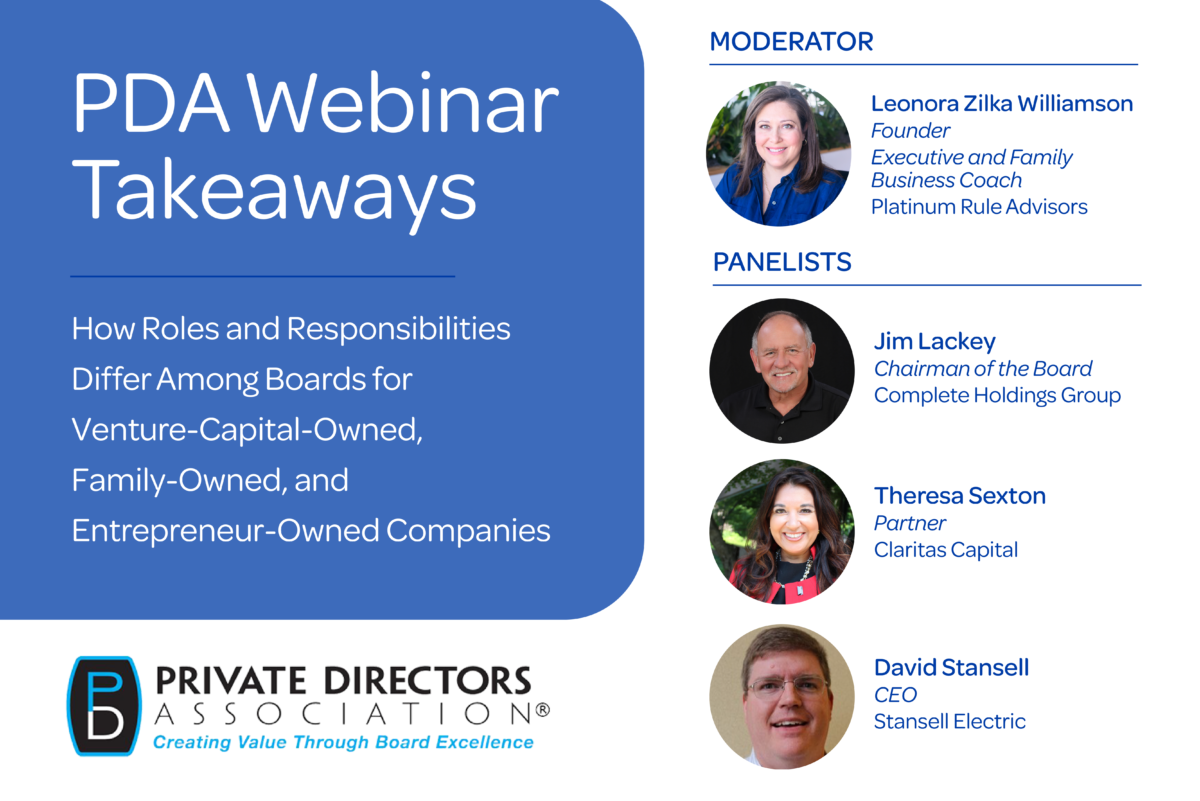Key takeaways from the Nashville Chapter of the Private Directors Association virtual panel
Boards have been on my mind a lot recently. Currently, I serve as a Director of a family-owned company, and have previously served on the boards of a couple of start-ups. Fiduciary board service is both spectacular fun and great responsibility. On the joyful side, you get input in setting strategy and serve as a sounding board for a CEO, among other activities. At the same time, you are always committed to your stakeholders – in my case, employees, above all.
I recently took my Vanderbilt corporate social responsibility students through a review of possible board structures ranging from publicly traded to ESOP, and how stakeholders differ in each. I have also been preparing to join additional boards myself and diving deep into the roles of various board committees.
On March 31, I had the opportunity to reflect on these questions when I moderated a panel for the Nashville chapter of the Private Directors’ Association with brilliant guests including David Stansell, CEO, Stansell Electric, Jim Lackey, Chairman of the Board, Complete Holdings Group, and Theresa Sexton, Partner, Claritas Capital. The topic was the difference in Director responsibilities on family, entrepreneur, and venture capital-owned companies – and we couldn’t have had a better group.
Below are a few takeaways from the conversation, but in a nutshell? Governance matters.
Every board has to think about succession planning, but the strategy may look different based on company ownership structure.
Theresa Sexton: In regards to succession planning, oftentimes we are backing teams. We have to look beyond the founder. It gives us a great level of confidence when the founder can build a highly competent team that’s smarter or even more talented than he/she is — it means the founder can step out of the way and the company can continue to grow and be successful.
David Stansell: As soon as there is someone available that can do the job better than me, that person should be president of Stansell Electric. A common misconception is that the person needs to be a family member, when instead they need to be the shepherd to new equity.
Jim Lackey: It’s crucial to understand that the founder may not be the most experienced or qualified person to help the company grow. When looking for a new CEO, start the process off with the idea that the founder has gotten you to this point, but it takes a different kind of person to be able to scale the business beyond foundation.
The most helpful qualities in board members include capital raising assistance, connections, and a strategic outlook.
Jim Lackey: The perfect board member knows my market and has a rolodex full of people to start connecting me to. A board needs to be strategic. I don’t need help on the operations side. I need help thinking outside the box.
David Stansell: What’s really helpful is having people with different perspectives and backgrounds who can point out something that might be holding you back. We look for people who are willing to tell us when we’re totally wrong or missing something and who can help navigate familial relationships when needed.
Theresa Sexton: There is tremendous value in a fresh perspective around the board, in youth and energy, and different or diverse views. Just because you haven’t been on ten boards doesn’t mean you can’t add value or a unique perspective that companies could benefit from.
Time horizons between family boards and other types of boards can look different, but it’s important for all CEOs to have clarity about what they need at any given point in time.
David Stansell: At different times you need different things. Right now, we’re hot and heavy on succession. People who have experience walking through that is helpful. Different times, different needs, different people.
Theresa Sexton: Because we’re talking about 3-5x return over 3-5 years, which could be only about 12 meetings total, board members need to be immediately impactful. In regards to succession planning, oftentimes we are backing teams and have to look beyond the founder. It gives us a great level of confidence when the founder can build a highly competent team that’s smarter or even more talented than he/she is. It means the founder can step out of the way and the company can continue to grow and be successful.
Jim Lackey: As a family business, you have to constantly reinvent yourself to stick around for another 25 years. Succession planning is important in a family business because you need to think about who’s next from a limited group of candidates.
Board members can contribute to company culture by ensuring the right CEO is in place.
Jim Lackey: The CEO should drive the culture, which is why so many firms change CEOs. They realize what it took to get to the first level isn’t what it’s going to take to get to the second and will pivot to make it happen.
David Stansell: The idea that you can either be a company that focuses on taking care of people, be a great place to work and have a great culture, or you can be a company that focuses on driving returns and getting results is a myth. You want both high performance and high fulfillment. If you have one and not the other, your company will not be sustained long-term.

